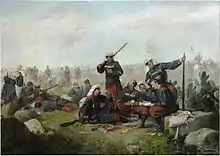Hispano-Moroccan War (1859–60)
The Hispano-Moroccan War, also known as the Spanish–Moroccan War, the First Moroccan War, the Tetuán War, or, in Spain, as the African War (Spanish: Guerra de África), was fought from Spain's declaration of war on Morocco on 22 October 1859 until the Treaty of Wad-Ras on 26 April 1860. It began with a conflict over the borders of the Spanish city of Ceuta and was fought in northern Morocco. Morocco sued for peace after the Spanish victory at the Battle of Tetuán.
| Hispano-Moroccan War | |||||||
|---|---|---|---|---|---|---|---|
.jpg.webp) Mariano Fortuny's depiction of the Battle of Tetuan, oil on canvas (MNAC). | |||||||
| |||||||
| Belligerents | |||||||
|
|
| ||||||
| Commanders and leaders | |||||||
|
|
| ||||||
| Strength | |||||||
| 40,000 | At least 35,000-50,000 | ||||||
| Casualties and losses | |||||||
|
4,040 dead [1] (1,152 in battle and 2,888 from disease) | 6,000 dead | ||||||
Background
Throughout the 19th century, Morocco suffered military defeats at the hands of Europeans powers, notably in the Franco-Moroccan War in 1844. In 1856 the Moroccan government signed the Anglo-Moroccan Treaty with the British which set the Moroccan customs duty at 10% and brought an end to royal monopolies.[2]
The course of the war
The casus belli for Spain were the unrelenting attacks of Berber tribesmen on Spanish settlements in North Africa; following unfruitful negotiations with Sultan Abd al-Rahman vis-à-vis the reparations (the latter, unable to control the cabilas, actually died in the midst of negotiations and was replaced by his brother Muhammad IV), a declaration of war propelled by Leopoldo O'Donnell was unanimously passed by the Congress of Deputies on 22 October 1859.[3]

The Spaniards reached Tetuán on February 3, 1860. They bombarded the city for the following two days which allowed chaos to reign free. Riffian tribesmen poured into the city and pillaged it (mainly the Jewish quarters). The Moroccan historian Ahmad ibn Khalid al-Nasiri described the looting during the bombardment:
A tumult broke out in the town,... the hand of the mob stretched out to plunder, and even [normal] people took off the cloak of decency.... People of the Jabal, and the Arabs, and the riffraff began to pillage and steal; they broke down the doors of the houses and the shops.... keeping at it the whole night until the morning
On February 5 the Spanish entered the city, ending both the battle and the war.
Aftermath

Following an armistice of 32 days,[4] the Treaty of Wad-Ras or Peace of Tétouan was signed on 26 April 1860. The treaty contemplated the extension on perpetuity of the Spanish presence in Ceuta and Melilla, the end of tribal raids on those cities, the recognition by Morocco of Spanish sovereignty over the Chafarinas Islands, the retrocession of the territory of Santa Cruz de la Mar Pequeña (a territory of uncertain location by that time, ultimately Sidi Ifni) to Spain in order to establish a fishing post, the permission to missionaries for establishing a Christian church in Tétouan, and the Spanish administration over the later city until reparations of 20,000,000 duros were paid.[5]
Once Morocco paid the compensation (partially through money lent by the British), O'Donnell retired his troops from Tétouan.[6]
References
- Warfare and Armed Conflicts: A Statistical Encyclopedia of Casualty and Other Figures, 1492-2015, 4th ed., Micheal Clodfelter, p. 199.
- Miller, Susan Gilson. (2013). A history of modern Morocco. New York: Cambridge University Press. p. 23. ISBN 978-1-139-62469-5. OCLC 855022840.
- Fernández-Rivero 2011, pp. 470–471.
- Villatoro, Manuel P. (9 May 2017). "El héroe vasco que defendió España frente a miles de rifeños en la épica batalla de Wad Ras". ABC.
- Romero Morales 2014, pp. 639–640.
- Romero Morales 2014, p. 640.
Sources
- Fernández-Rivero, Juan-Antonio (2011). "La fotografía militar en la guerra de África: Enrique Facio". Ceuta y la Guerra de África de 1859-1860 (PDF). Ceuta: Instituto de Estudios Ceutíes. pp. 459–492. ISBN 978-84-92627-30-1.CS1 maint: ref=harv (link)
- Romero Morales, Yasmina (2014). "Prensa y literatura en la Guerra de África (1859-1860). Opinión publicada, patriotismo y xenofobia". Historia Contemporánea. Bilbao: University of the Basque Country (49): 619–644. ISSN 1130-2402.CS1 maint: ref=harv (link)
- (World History at KMLA)
- Moroccan War 1859-1860
- "A History of Modern Morocco" pages 24–25 Susan Gilson Miller, Cambridge University Press 2013
| Wikimedia Commons has media related to Hispano-Moroccan War (1859–60). |